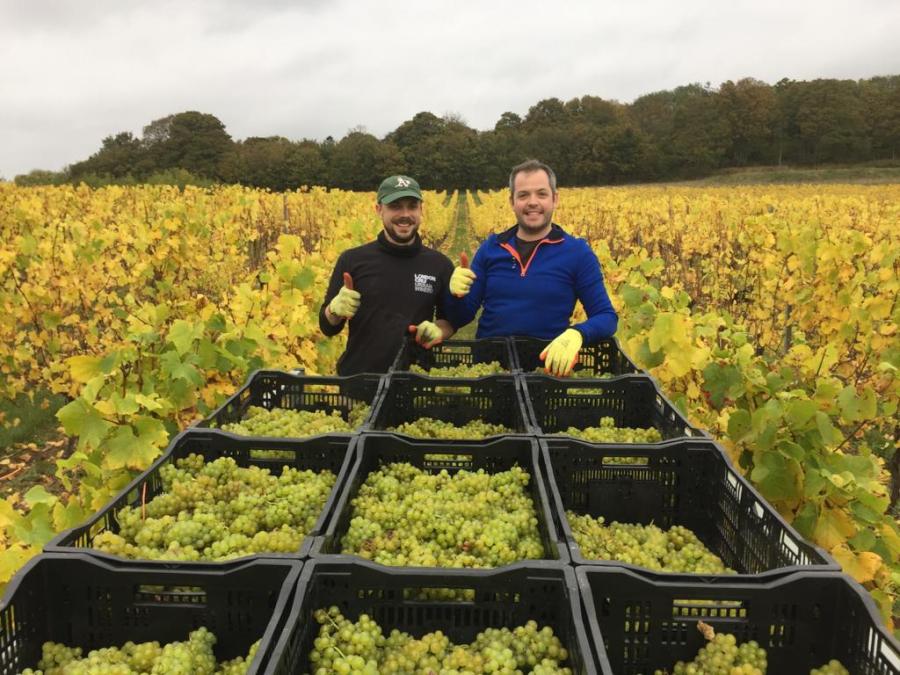Every season has its ups and downs, influenced by Mother Nature and Jack Frost. This year shortage of labour and the dreaded downy added to the challenges. 2021 included blood, sweat – and probably lots of tears! But despite the hard work and sleepless nights, harvest is a magical time and a chance to celebrate the new vintage. Vineyard captures some photos and comments from across the regions and Stephen Skelton’s annual harvest survey.
Each year consultant viticulturist Stephen Skelton MW sends out a survey to growers to provide some of the data, facts and figures useful for understanding the season and for benchmarking performance. “My summary this year is from data collected from 75 separate vineyards covering 360-ha of cropping vineyards, and showed an average yield of 5.24 tonnes/ha (2.12 tonnes/acre) with sugar levels at 8.75% potential alcohol and total acids of 11.84 g/l (as tartaric). However, these figures are from a relatively small, self-selected number of producers, and do not contain data from many of the less successful vineyards. This makes them less reliable than I would like,” commented Stephen.
“2021 will be remembered by many producers as a year with a late start, indifferent summer, and a problematic growing season. For some, this resulted in high levels of disease leading to poor, even very poor, yields. For others, much to their surprise, the late flowering coincided with good weather leading in some cases to above average yields. To hold onto their crops excellent canopy management, especially de-leafing, was required, plus effective and timely spraying. These measures helped keep disease, most noticeably downy mildew, under control, and growers were able to harvest clean fruit.
“Whilst sugar levels were only very slightly down on average, acid levels were significantly higher than average, suggesting a good year for long-aged sparkling wines, and less good for quick-drinking still wines.
“GDD (Growing Degree Days) only start accumulating when the average daily temperature rises above 10˚C. In 2021, this didn’t start happening until about 10 May. By the first week of June, the GDD were well behind the long-term average, although they caught up during the summer and early autumn.
“With all this cold weather, the vines were held back, and despite terrible reports of frost damaged vines in France and other parts of Europe, many vineyards in Britain escaped frost damage as their vines had barely burst their buds.
“Very surprisingly, despite the late spring with its frosts, despite the patchy flowering weather, despite the lousy summer and late veraison, despite the indifferent October, in many vineyards crops have been relatively successful. Several vineyards have reported yields of the 2019 level (second highest of recent times), with fruit clean and ripe. Acids are high, perfect for sparkling, but not so good for the still wine brigade. Mind you, it wasn’t all sweetness and light as many growers struggled (and in some cases failed) to keep their crops clean and so their harvests are small,” concluded Stephen.
John Buchan, agronomist, saw a distinct north-south regional divide. “This was mainly due to the less extreme weather conditions further north. The north in general had less disease and higher yields. The west was a mixed bunch being quite late to harvest due to high rainfall, but disease was less of a problem. This year disease was more severe in the south-east with downy mildew hitting very early on. Yet again canopy management was shown to be of particular importance and early significant leaf removal of benefit. In addition, the supply problem of some products unfortunately compromised program decisions,” commented John.
WineGB Wessex
“In general, the feeling across the region is that 2021 has been a long challenging year, but that the harvest has been a success,” commented Jacob Leadley, Winemaker and CEO, Black Chalk, and chair of WineGB Wessex. “A shortage of pickers provided an additional logistical challenge and many producers turned to local volunteers to help ensure the crop made it to the winery in good shape. In my opinion the long growing season has provided some great fruit, delicate and showing great promise for the future wines,” Jacob added.
“It was an unforgiving year for most, a long cold start to the year with a number of frost events, before disease pressure became very high in August. It was a year where the skill and work ethic of the vineyard manager was really put to the test,” exclaimed Jacob.
“In general acids were slightly higher than recent vintages but well within acceptable levels for quality winemaking, while our sugar levels were very good considering the growing season. Harvest was late for many, but the weather did improve and help to ripen fruit in those last warm and dry days of October. The shortage of pickers also meant it was a more drawn-out vintage for many,” said Jacob.
“A very challenging year and one that has been hard fought by James Matyear our vineyard manager. In the winery Zoë Driver and I are delighted with how the wines are showing at this early stage, with all the Pinots really shinning, in particular. It was a long, slow pick and needed a huge effort by the whole team to get us over the line,” commented Jacob. “We needed as many pickers as possible, so when a very old friend turned up in the vineyard by surprise, I immediately gave him some snips and had him picking for the rest of the day while we caught up,” smiled Jacob.
“Due to a shortage of pickers, our 2021 harvest was a ‘all hands-on deck’ affair with our whole team supporting alongside an enthusiastic group of locals. In a challenging growing year, we’re very pleased with the ripeness and balance of acidity, as well as a higher yield than 2020,” said Fred Langdale, Vineyard Director at Exton Park.
“If you survived the frosts in Spring, the wet and humid weather in Summer and held on at the end of the year allowing the fruit to hang, by the skin of your teeth, then you may well have had an excellent year. We had great yield and superb quality,” commented Nat McConnell, Bluestone Vineyard.
“The 2021 harvest at Hattingley was late but not the latest, the yield was on the lower side – but perfectly formed. No disease and completely clean, our huge team of local volunteers, assembled by our Vineyard Manager Colin Hayward, got the crop in safely and in record time. The Pinot Meunier was the star of our chalky Hampshire site this year and is showing great promise in both barrel and tank. We are looking forward to making some epic sparkling wines from the 2021 vintage – a bit like 2015, this one will reward patience and given time will really shine,” said Emma Rice, Director and Head Winemaker at Hattingley Valley.
“This year’s harvest was our best yet, even though we had to push the harvesting dates back by a month due to the lack of sun – none the less when the grapes were ready to harvest, they were spectacular. We got the biggest yield to date, much bigger than we anticipated but a very pleasant surprise. We harvested each variety twice ensuring that during the first harvest we only picked the very best of the grapes for our single variety still wines, the second harvested grapes we will be using for our blended wines and sparkling. We’re really thankful to everyone who helped and can’t wait to try the wines,” commented Charlotte Self, Whitehall Vineyard.
WineGB Midlands & North
“Laurel Vines had a very good year, our second largest harvest to date – and I have heard similar stories from other Yorkshire vineyards. Nice clean fruit and plenty of it.
A late start to the year saw us clear of any significant frosts, with bud burst in early May. August was not helpful and so a lot of effort was put into preventing disease, but September and October allowed the fruit to ripen. A late harvest, with the last picking date on 22 October,” commented Ian Sargent, Laurel Vines and chair of WineGB Midlands & North.
WineGB West
“There is no doubt about it, this year has been challenging,” commented Tommy Grimshaw, Head Winemaker, Langham Wine Estate. “However, through dedicated hard work, meticulous attention to detail and a fair amount of good fortune, we have emerged from the other side of a very successful harvest. The late frost set us back and we didn’t have a particularly good summer with constant disease pressures, however Olly Whitfield, our Vineyard Manager, did an excellent job of managing the canopy to ensure that there was good air flow and as soon as the sun showed up at the start of October, we were in a position to capitalise on it. We picked late this year and sugars were a bit low with acids slightly high – but for me this isn’t nearly as important as the phenolic and flavour ripeness. We are already seeing incredible levels of depth in flavour which is due to the long and cool growing season,” added Tommy.
“Another massive challenge this year was the harvest work force. In previous years we have relied on overseas staff to pick for us but like many other growers, we really struggled to get the staff this year. We turned to the local people here in Dorset – we called out via radio, newsletters, social media and even posters in the local pub, and fortunately we had a lot of success. The buzz around the place was exceptional, and we can’t thank the wonderful crew that came to pick for us enough – they really saved the harvest!
“A huge amount of credit needs to be given to the vineyard managers around the country this year for their hard work. Now it’s up to us in the winery to make the most of it,” smiled Tommy.
“As for us at Higher Plot vineyard – we’d have to sum it up as small but perfectly formed,” commented Guy Smith, Chair of WineGB West. “We got beautiful ripe fruit but downy earlier in the season took its toll on the quantity. The best description for the WineGB West region would be mixed – Aldwick Estate had their largest ever crop at nearly 10 tonne per hectare,” Guy added.
WineGB East Anglia
“The general feeling in the East is that yields are up, and quality is just above average considering the lateness of the season,” commented Laura Robinson, Burn Valley Vineyard and chair of WineGB East Anglia. “One slight struggle was trying to get pickers.”
“Here at Burn Valley, we harvested Solaris at just over 100 °Oe (degrees Oechsle), with acids at 7.5-8 g/l. Our Bacchus was around 70-85 °Oe, with acids at 9-10 g/l, the early Pinot was 75-85 °Oe, with the Pinot clone 777 picked locally at 11.3 acid and 87 °Oe – very good for north Norfolk!
“We had a cooler summer for sure, but the long dry autumn in Essex was a blessing for quality,” commented Duncan McNeill, South Bank Vineyard and McNeill Vineyard Management. “We’ve had a cracking vintage this year, with dry conditions in October and November enabling the vital ‘hang time’ needed to produce physiologically ripe fruit. We harvested still wine clones of Pinot Noir between 93-98 °Oe across six sites in the Crouch Valley. Sauvignon Blanc at 89 °Oe, Pinot Blanc and Pinot Gris both at 92 °Oe, Chardonnay at
89 °Oe. Due to the extended hanging time, some of the primary fruit flavours in the grapes were just superb,” Duncan added.
WineGB South East
“We had the late frosts in April, rain at flowering time, long runs of days with little sunshine and then warm, wet weather into harvest,” commented Julian Barnes, Managing Director, Biddenden Vineyard. “Harvest began 10 days later than in 2020, on 20th September 2021, but was swift as picking was complete in less than a month with the final variety, Gamay Noir, picked on 18th October 2021.” Julian added.
“We very much work to the belief that winemaking happens in the vineyard and in a year like 2021, this is proven. We have a strong focus on agronomy, we’ve been meticulous about ensuring the vines have been at optimum health to ensure the best possible picking at harvest time. Picking at Biddenden is carried out by local people who work through each variety by hand, before being pressed on site.
“This year we are doing some trials to directly compare hand picking and machine harvesting on one block of Bacchus – the first time this has been done in the UK,” commented Tom Barnes, General Manager, Biddenden Vineyard.
“Ortega, our signature variety, is always the first to be picked, before working through other white varieties including Bacchus and Reichensteiner, then on to reds such as Dornfelder and Gamay Noir,” explained Tom
“Despite being one of the most challenging seasons we have ever seen, I’m excited about all the wines we have in tank and how they will develop,” Tom added.
Welsh vineyards
“Vineyards across Wales reported a good clean harvest, though with low sugars on some varieties, especially the later ripening varieties,” Reported Oliver Richardson, Welsh Vineyards Association secretary.
“At Llanerch Vineyard, Ryan Davies reported great weight and clean grapes, with 14.6 tonnes harvested. At White Castle near Abergavenny Robb Merchant had an above average good clean harvest, with harvest dates running a week later than usual and grape bunches were a little smaller. Overall south-east Wales had a good growing season with a dry warm autumn,” added Oliver.
“In Pembrokeshire, Andy Mounsey at Velfrey reported a similar story to that at Llanerch – with high yields, with the equivalent of over eight tonnes per hectare from Seyval Blanc. The fruit was very clean, but with lower sugars than in previous years. However, the yields of Solaris and Pinot Noir were much lower.
“At The Dell vineyard at Raglan, the Alford family took their first crop from a vineyard that they have just taken over. They managed 0.25 tonnes from a largely unpruned plot – the birds ate the rest! The grapes have been sent to the Mountain People winery to make an skin-contact white wine.
“Mike Phillips at Blue Moon vineyard in Radnorshire had around a ton of grapes from Solaris and Cabernet Cortis vines. The Solaris cropped at 75 °Oe. and the reds 73 °Oe. The Solaris had to be picked rapidly because of the interest shown by wasps. Mike hopes for a better crop in 2022 as more young vines come into production and has plans for more vines planting next spring,” concluded Oliver.
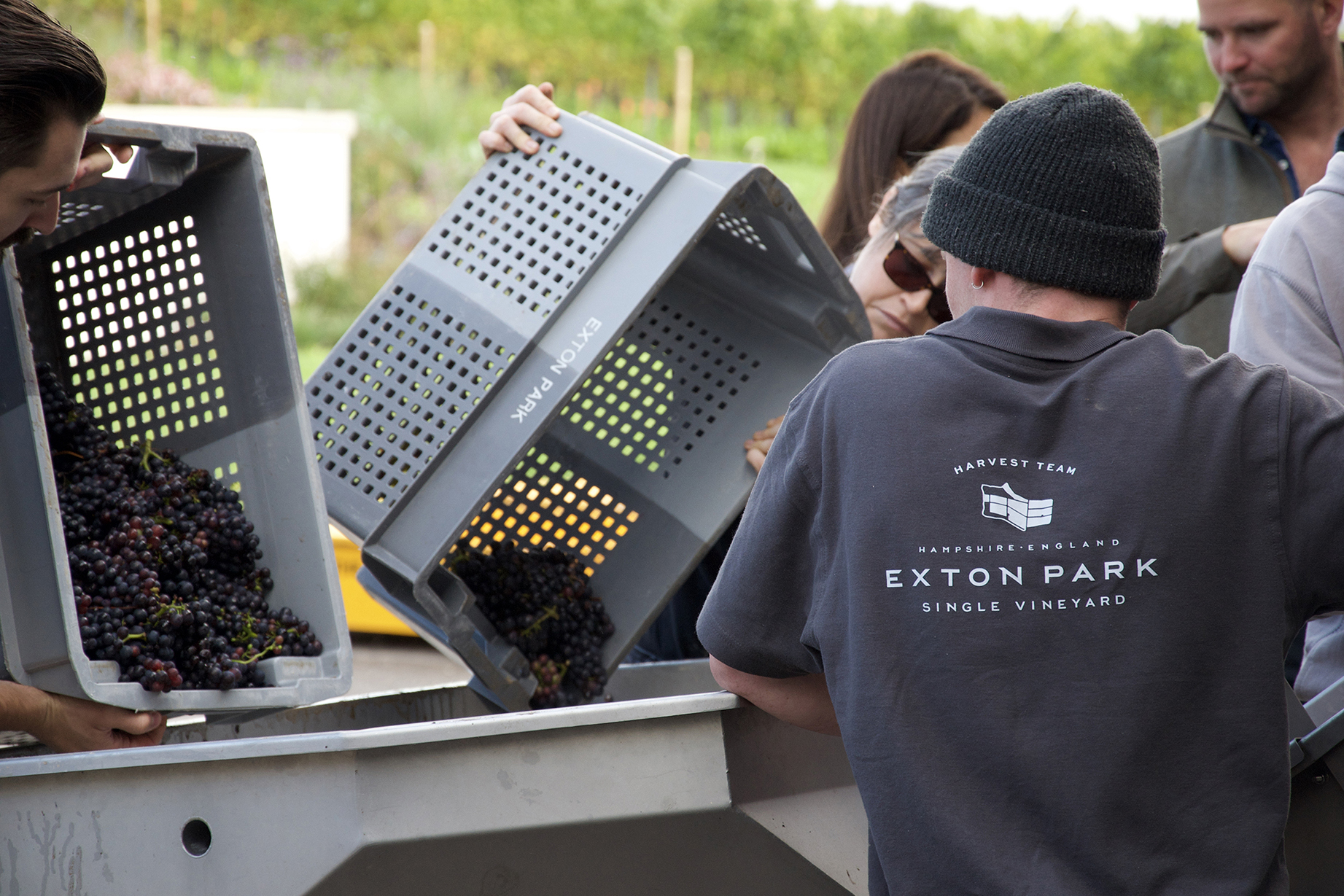
2021 harvest was a ‘all hands-on deck’ affair at Exton Park 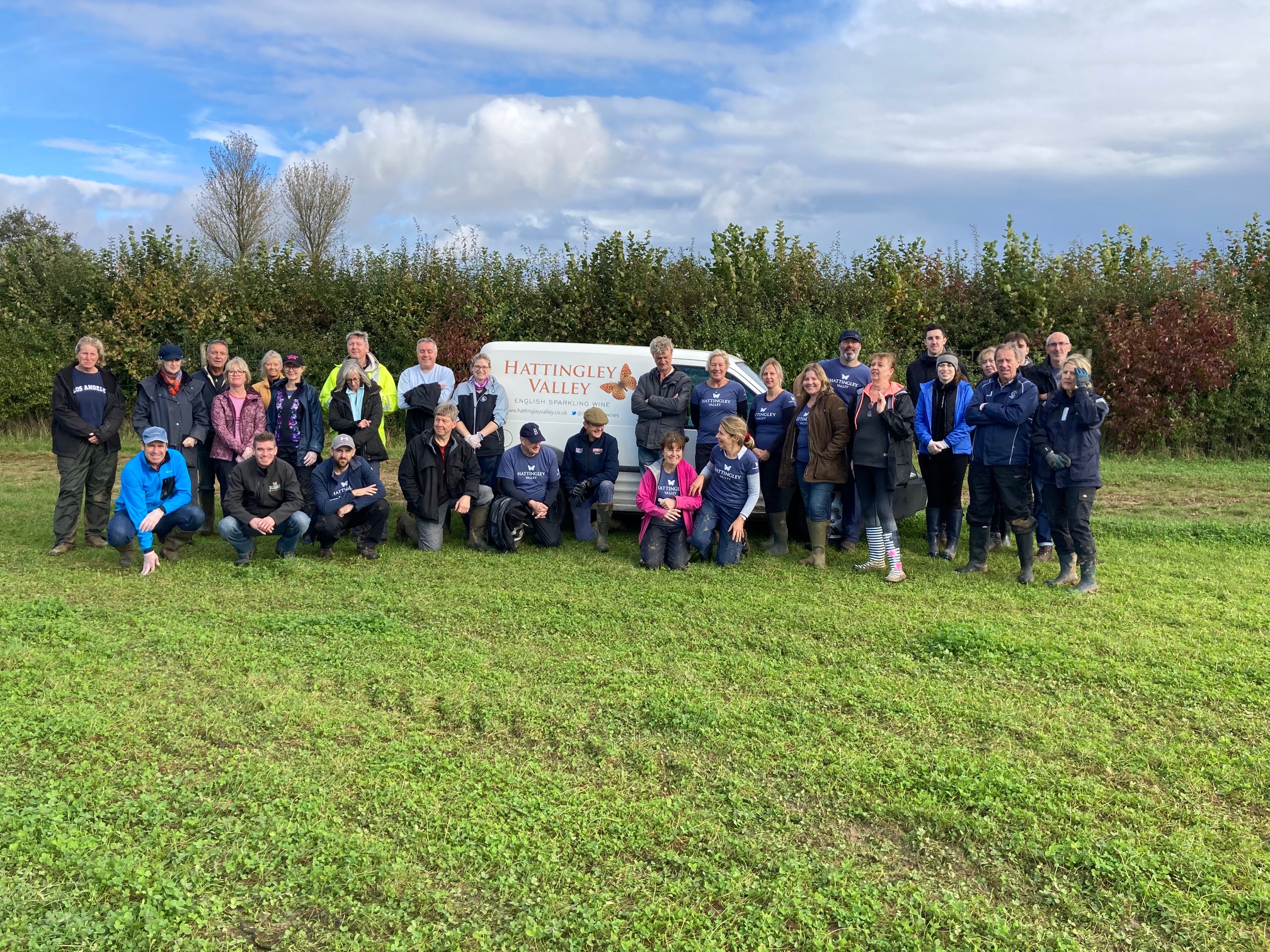
Harvest team at Hattingley Valley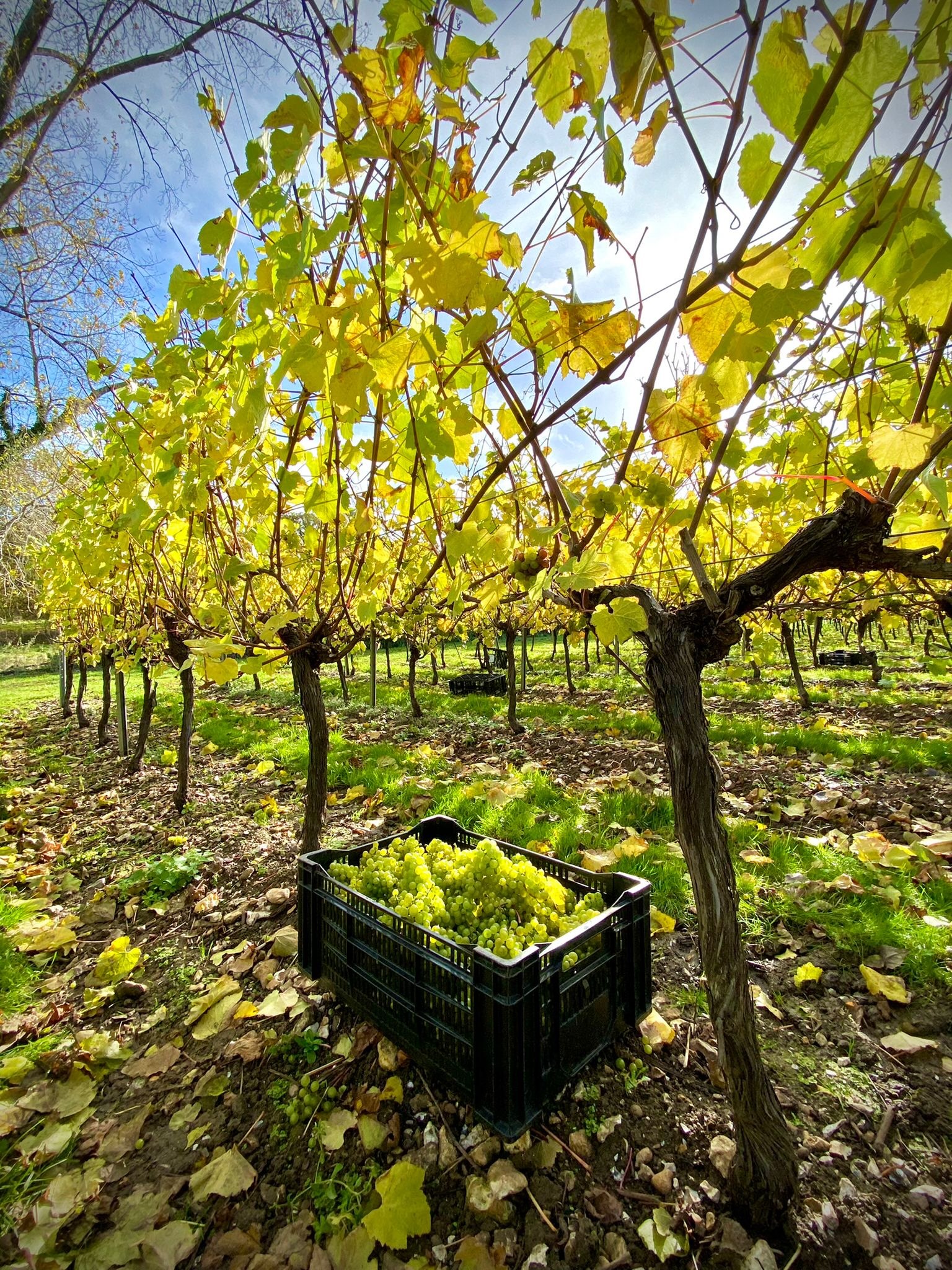
2021 has been all about patience, teamwork and volunteers at Raimes Vineyard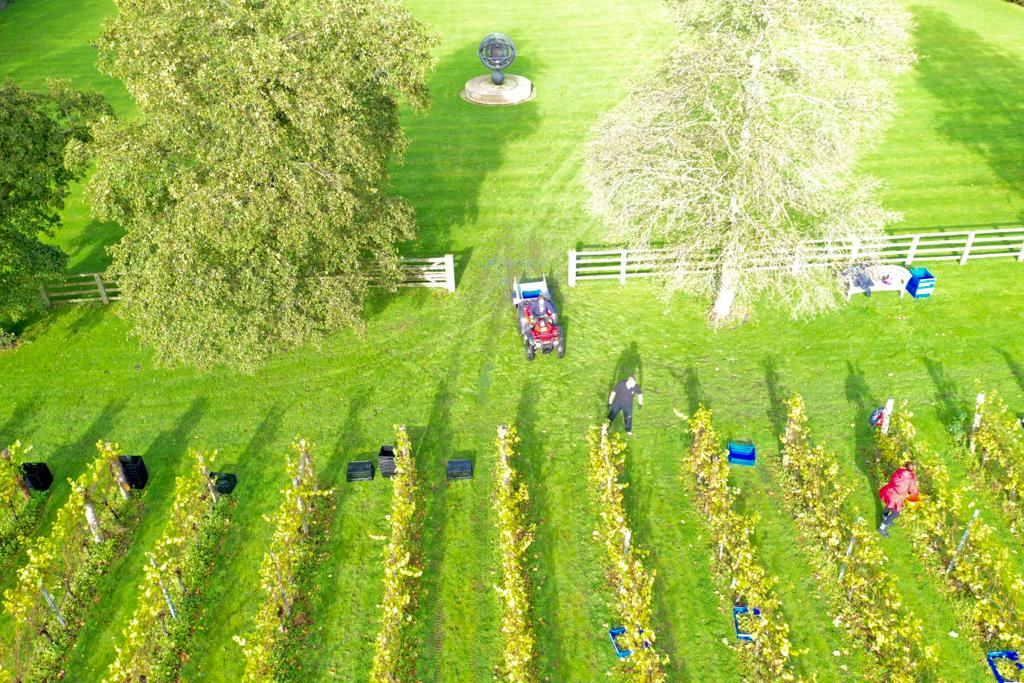
Harvest action at Southcott 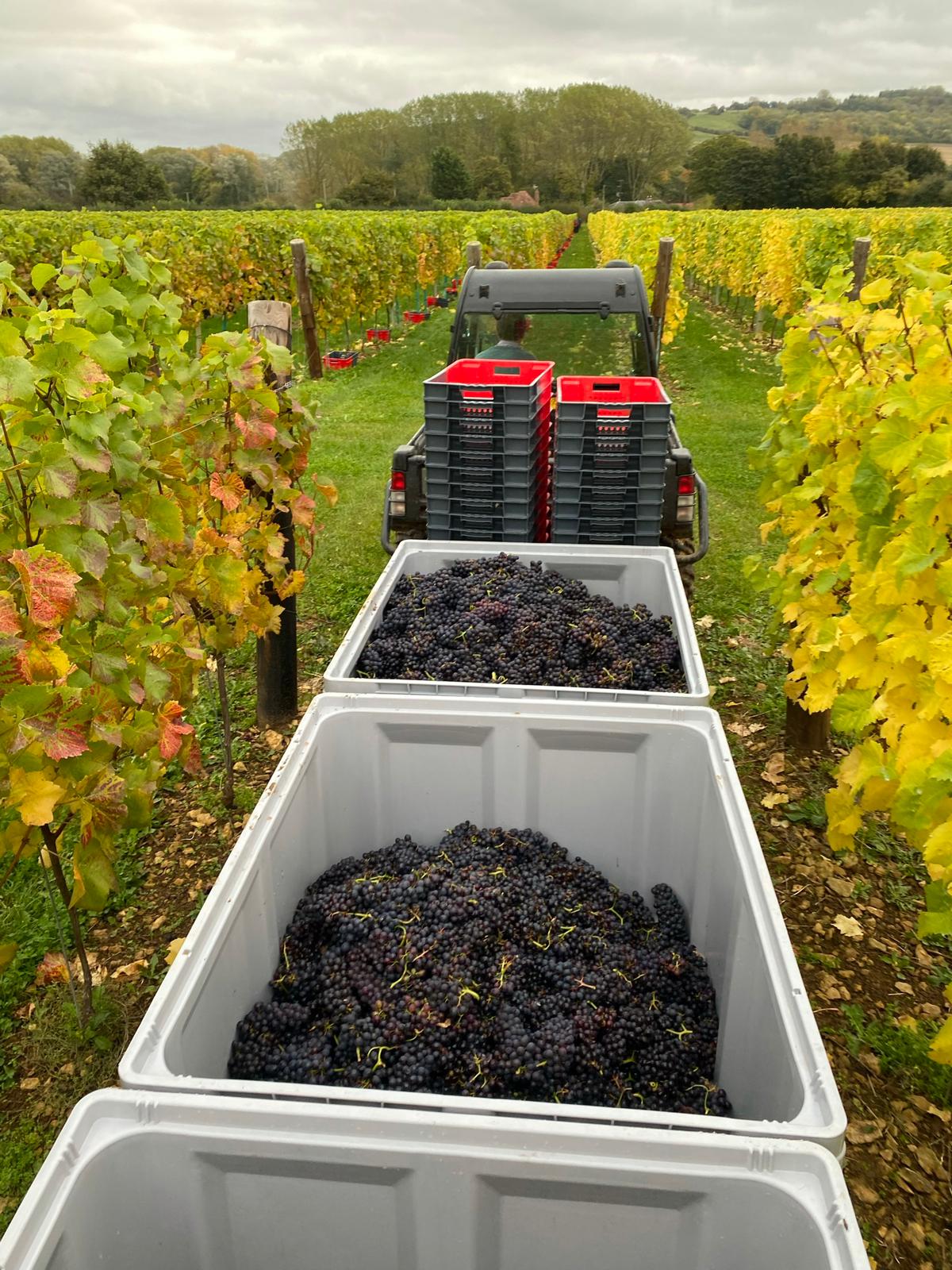
Largest yield to date at Whitehall Vineyard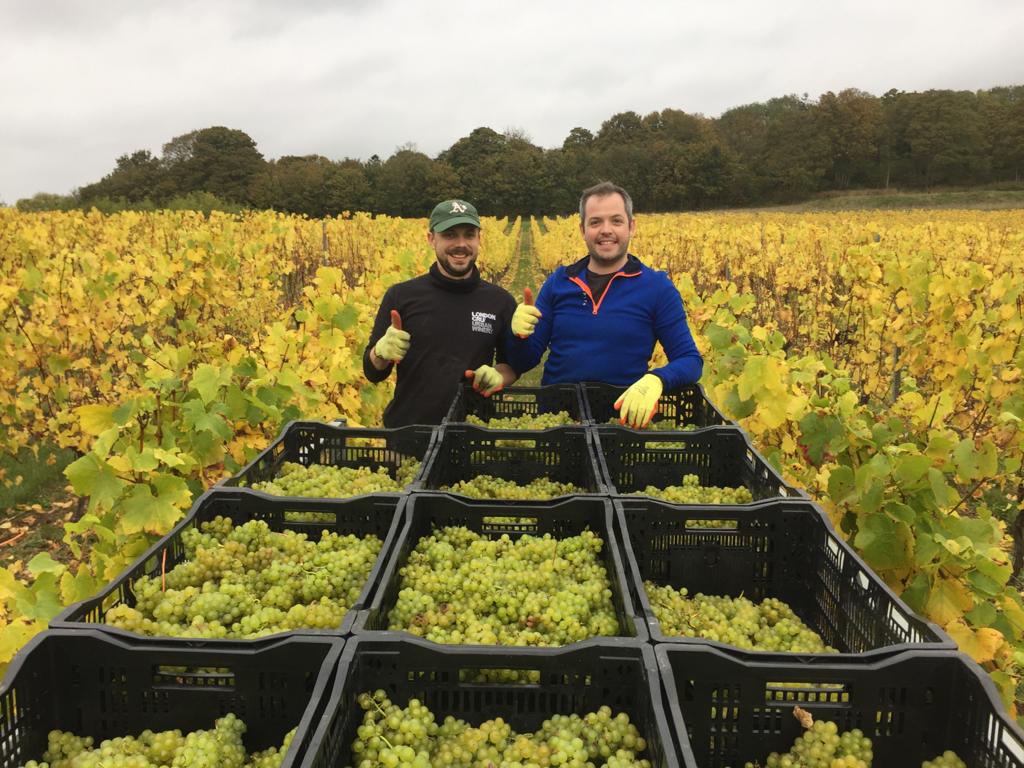
Bringing in the harvest at Black Chalk 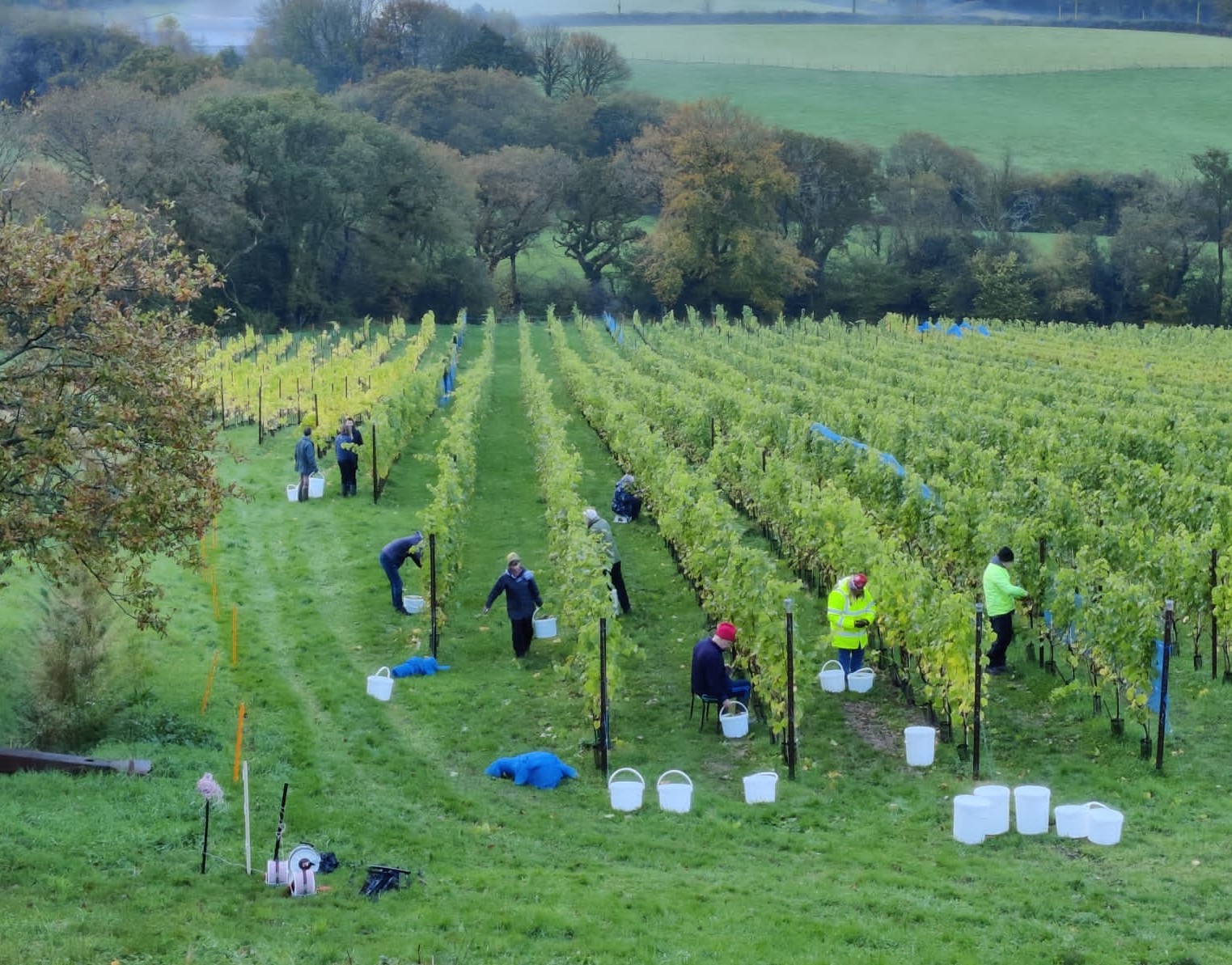
Picking at Velfrey 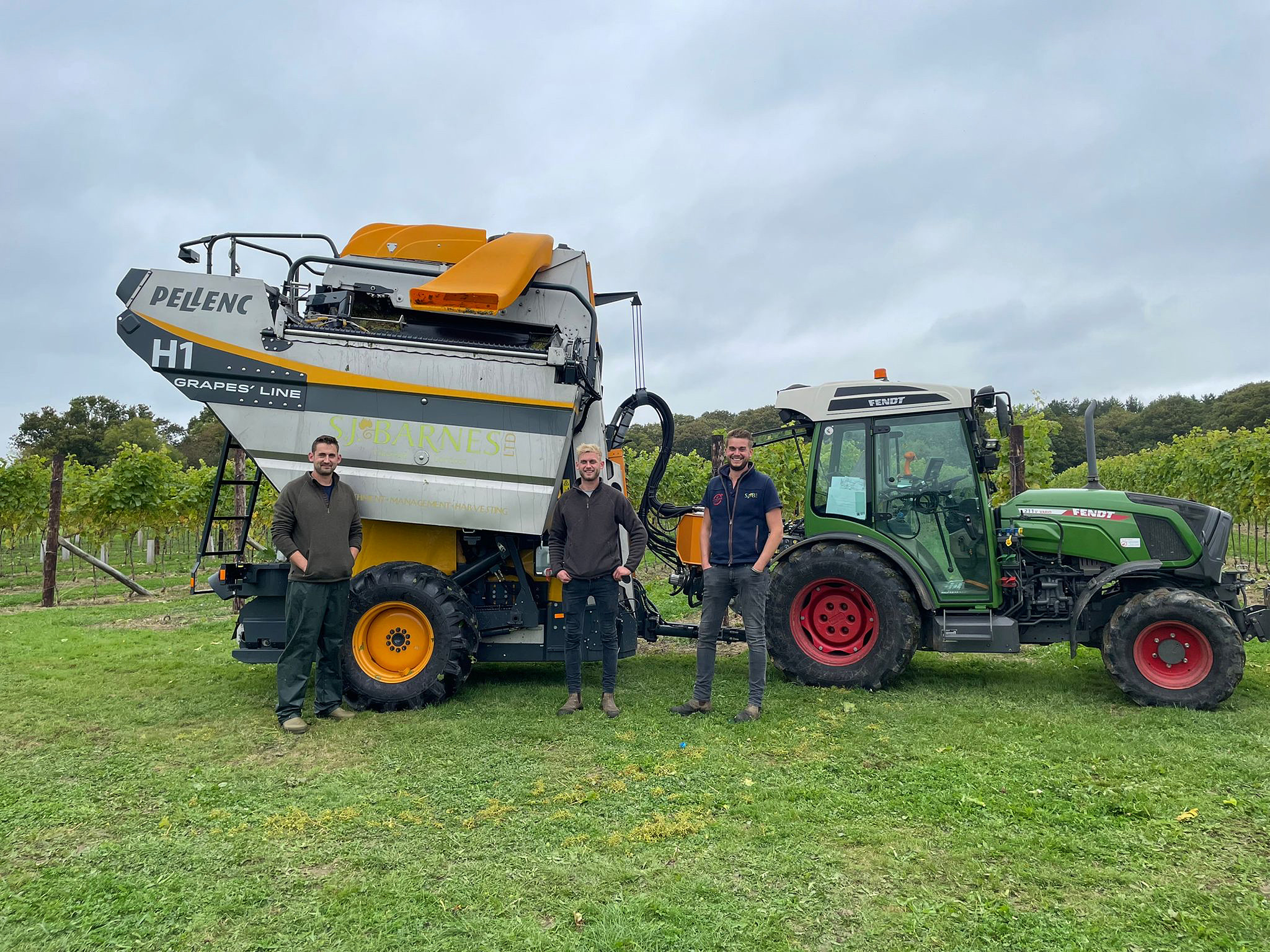
Tom and Will Barnes, Biddenden Vineyards and Sam Barnes, S J Barnes with the Pellenc Harvester as supplied by N P Seymour used as part of trials with Bacchus at Biddenden Vineyards 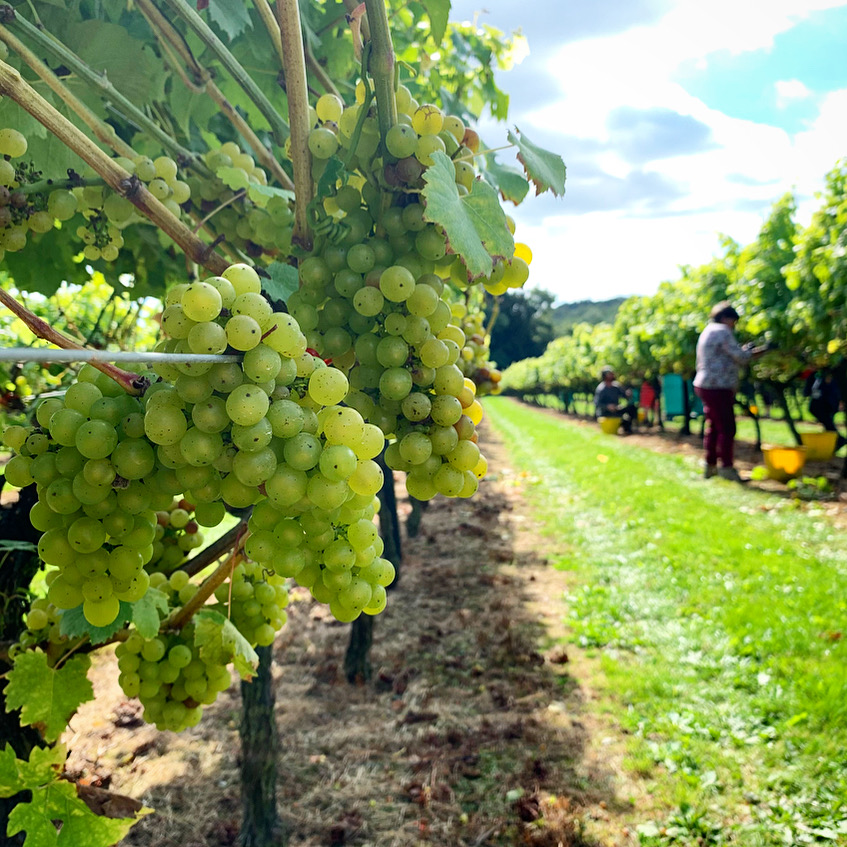
Ortega Harvest at Biddenden Vineyards 2021

